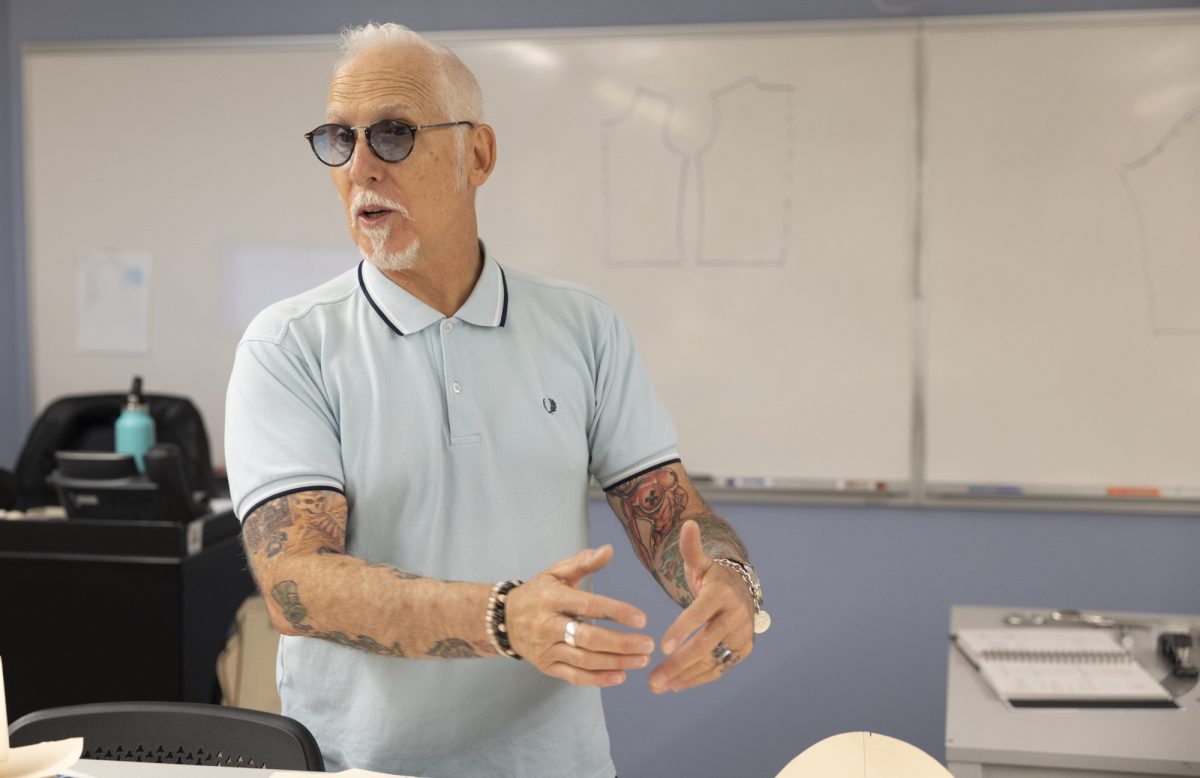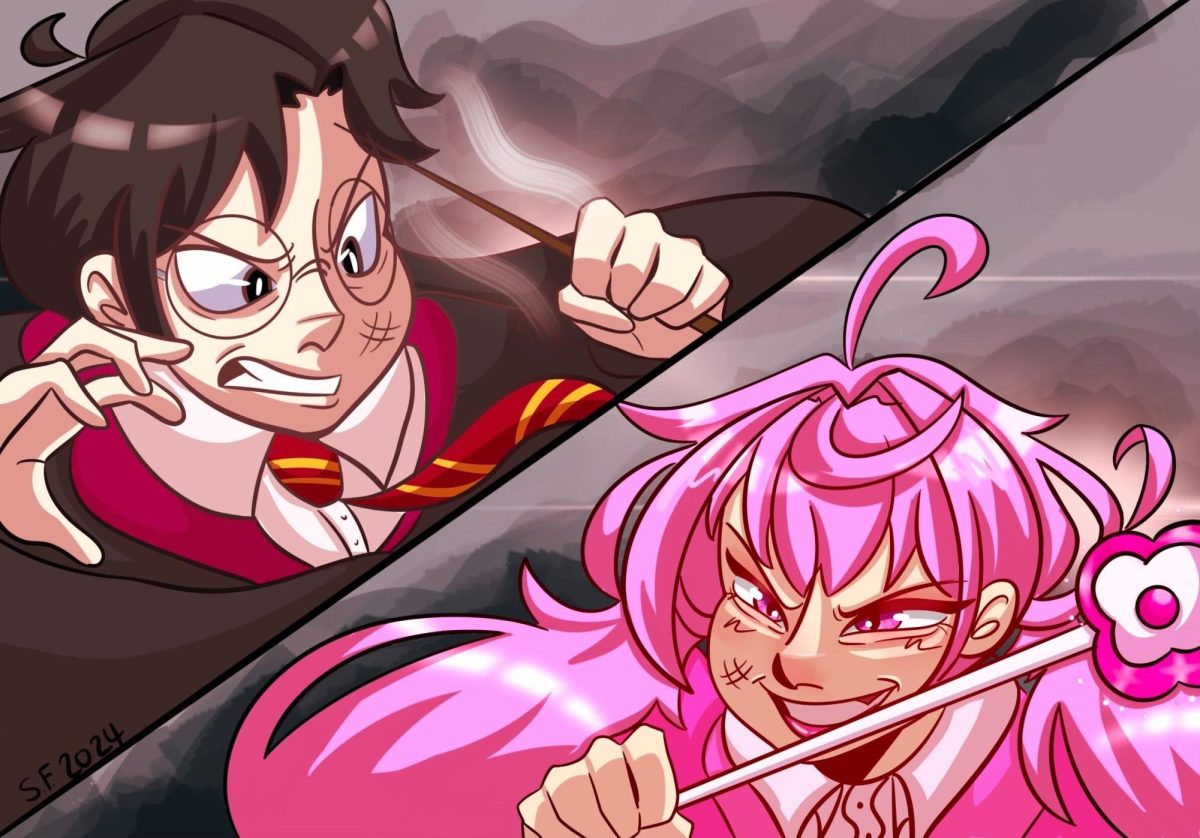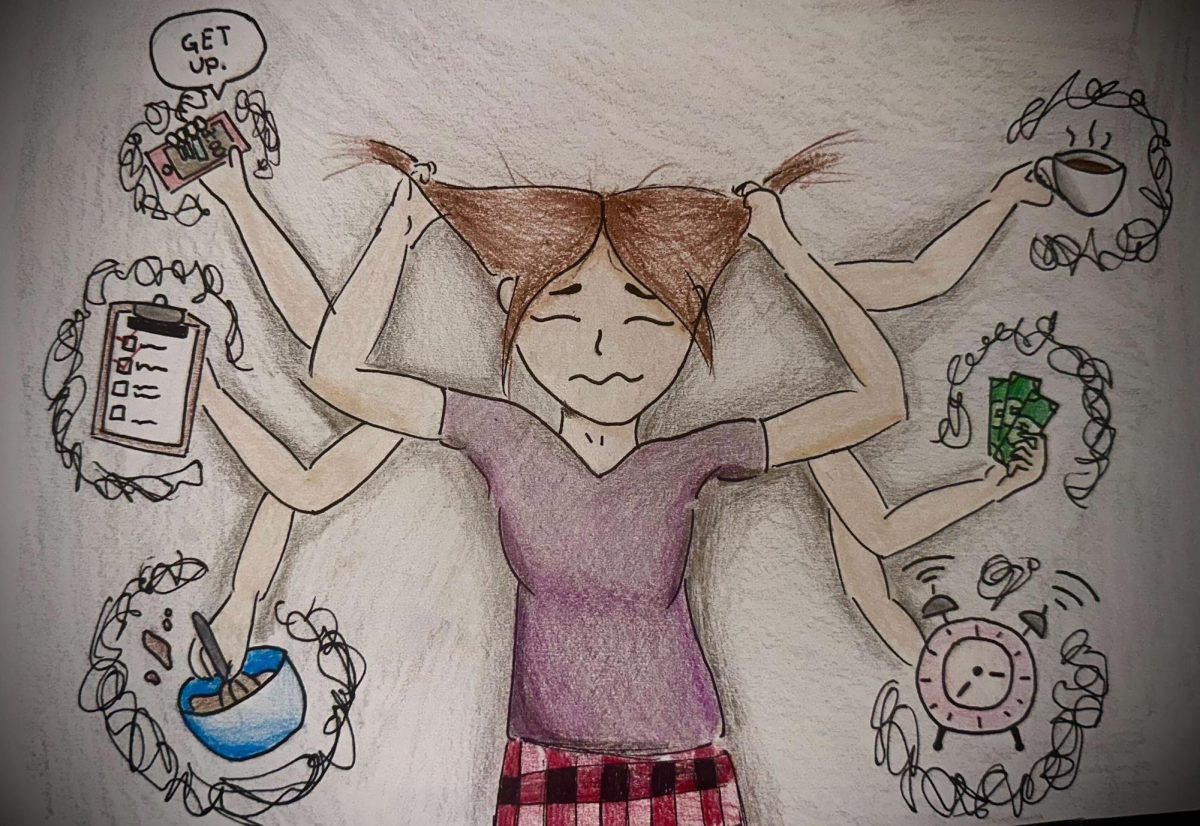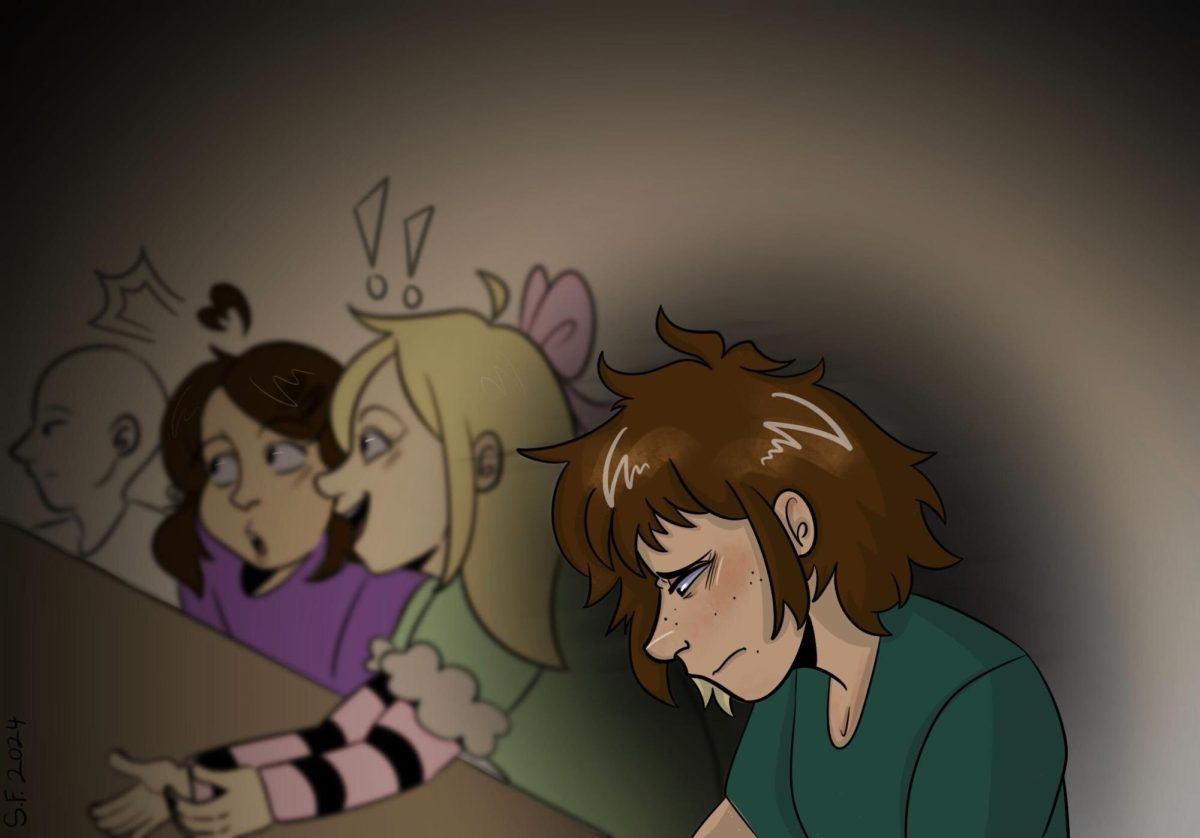Will Hoover’s epiphany appeared as he lay on the gravel of Yorba Linda Boulevard.
The night started strong with conversations over pizza and drinks. A beer and a half later, at 50 mph, Hoover is a blur as he makes haste into the night.
Seconds later, he’s airborne.
A drunk driver hits him head-on, propels him 50 feet and for those first 15 seconds on the ground, Hoover realizes that his days are numbered.
Now, 13 years later, Hoover is bringing his new lease on life into the classroom.
At 58 years old, he’s making a name for himself.
New to El Camino College, the part-time pattern instructor has spent the last 23 years in the fashion industry, curating his brand and dabbling in other creative endeavors with the hope of abolishing fast fashion and guiding the minds of the next generation of fashionistas.
All of which became possible as recovered from his brief brush with death.
Naturally, the journey to this point in his life is no short feat as he faced a tumultuous childhood and a new way of conquering life.
He grew up in Fullerton, just 10 miles up Harbor Boulevard from Disneyland, where he’d watch the nightly fireworks from his backyard.
As he got older, his teen years consisted of surfing sessions in Huntington Beach or riding motorcycles in the oil fields by his home.
However, a passion for design manifested thanks to the influence of his surrogate grandmother, Mrs. Della Hensley, who cared for him and his older sister and taught Hoover how to sew when he was 5.
A sewer in the factories in Los Angeles in the 20s and 30s, Mrs. Hensley, taught Hoover how to use his mom’s old Singer.
He boils down his childhood into four words: good, combative, interesting and mind-boggling.
“It was good because our generation didn’t have technology,” Hoover said. “Which meant my mom would say go outside and play, and we would.”
However, as he embraced his new creative outlet, it became a point of contempt between him and his mother as she tried to snuff out this interest.
It wasn’t until he was well into adulthood that he could make sense of her behavior and concluded that creative people are outside of the box and anything outside of that is seen as unsafe, uncertain and scary.
One of the first designs he shared was a pair of jeans that he cut up and patched back together, but being a designer wasn’t in the cards yet.
Even as he experimented with his looks, taking inspiration from bands including Duran Duran and David Bowie, he spent the last quarter of his high school education immersed in art classes, where he excelled and took an interest in watercolors.
In 1984, he enrolled in Orange Coast College as an art student, partaking in various mediums, from photography to sculpting and computer graphics.
“At the time, in my late teens, I didn’t have the courage to be a starving artist,” Hoover said. “So, I was trying to expand my thinking.”
Hoover admits that a primary reason he got into fashion was his interest in how things are made and the overall creation process.
“I realized as a designer, I was really interested in how screen prints are made or how embroidery is done or how a wash or dye is created,” Hoover said. “Being the star designer wasn’t as important as just knowing how to build garments properly.”
Entering his early twenties, Hoover took on the position of a production artist for a needlepoint company, hand-painting needlepoint screens before a co-worker introduced the Fashion Institute of Design & Merchandising (FIDM) as another stepping stone into his career.
After graduating in 1987, it would be another 12 years before Hoover got his first pattern-making job at the institution he studied, but only after gaining experience at major skate and surfing brands Gotcha and Ocean Pacific.
With ten years of official pattern-making instruction, Hoover admits he spent more time at FIDM than he intended, pointing out issues with the administration and their lack of ability to adapt to the current fashion and generational climate.
As he dealt with a lackluster administration, Hoover encountered two events that would change the trajectory of his life—starting with the discovery of his birth parents in 2006 and 2010.
His older sister, whom the Hoovers also adopted, helped connect him to a woman specializing in family reunification.
“I called her. She was in Nashville. I called her at seven o’clock my time and before I’d left for work at 8, she called me back and gave me my birth mother’s maiden name,” Hoover said. “By three in the afternoon, I was talking to my birth mother.”
Hoover can only describe the experience as surreal.
“I’d gone 42 years and I always saw myself as a potted plant,” Hoover said. “You’re of this world, but you’re not planted in it, and I always speculated why, and I found out, and within weeks of phone conversations, we laughed similarly. She understood me.”
Four years later, he was reunited with his birth father.
An interesting character, his birth father, had his own experiences in the film industry before moving on to be part of the original HALO skydivers and jumping close to the atmosphere.
When Hoover found him and met him, he was a quadriplegic at a VA Veterans Hospital, just 5 miles away from his home in Lakewood at the time.
Earlier that same year, he was also recovering from a motorcycle accident that made him question his mortality and the summers he had left.
He says he has about 20.
He can still recall the 10 to 15 seconds he lay on the ground, his body wadded up with only a broken small toe and a subsequent amount of PTSD and for the next two years, four days a week, he was in a doctor’s office, undergoing physical and psychological therapy.
“That changed a lot of my perspective of life and important things,” Hoover said. “I started thinking in that perspective, the 20 summers thing.”
Notably, it inspired an interest in leatherwork.
While paramedics attended to Hoover, they cut him out of the leather jacket he was wearing at the time of the accident.
Remarkably, he could sew it back together since only the lining was cut. After a few alterations and notable scuff marks, he still wears it to symbolize the battle scars he earned that day.
In turn, it also reignited his desire to extinguish fast fashion and as he eases into his new position at El Camino, Hoover plans to do just that.
In the classroom, Hoover is a powerhouse whose presence attracts attention.
Not one to simply sit behind a desk, he calls students up for a demonstration, carefully explaining each detail, from measurements to clothing movement. He uses himself as an example, contorting his body in different positions to show where the fabric stretches and tightens.
His teaching style manifested based on his preference for retaining information.
“I remember being in school, and it didn’t matter if it was in high school. I was always a visual learner,” Hoover said. “I’d get really pissed when an instructor would say this is what we do, and just do it this way.”
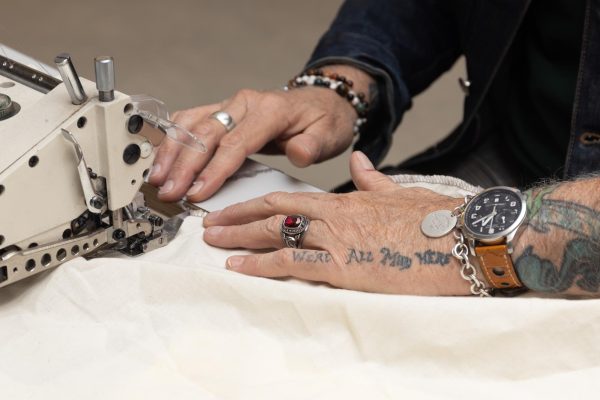
It pays off as his students hang on to his every word.
Fashion design major London Matlock, 22, appreciates Hoover’s teaching style and personality
“He’s a great professor. He helps in any way he can,” Matlock said as she maps out a pattern for a dress. “We were discussing cars and that has nothing to do with fashion and it was just very helpful. He’s very humble and very insightful.”
In the same breath, fashion design major Albert Bolanos, 32, echoes the same sentiment as he notes Hoover’s years of experience.
“He’s a pool of knowledge. His knowledge is worth so much, and he’s a very good storyteller because of his experience,” Bolanos said.
With that 23 years of exposure, Hoover, alongside fashion department coordinator and professor Vera Ashley, is working on creating and teaching a new program course to be ready for enrollment in fall 2024.
Currently, it’s just an idea still in the works, only discussed in e-mails back and forth, but to Dr. Ashley, the new class is intended to help anybody who wants to start or is doing an online fashion business.
As Dr. Ashley puts it, many people start with ideas, sometimes great ideas, but they don’t know how to execute them, find funding materials and end up failing or not doing as well as they should.
“I’m super excited about it, and I think it’s going to help out students,” Dr. Ashley said. “That’s extra information for them because they’ll get a trained instructor that can guide them to make their business successful.”
A subject Hoover is well versed in as he creates his label, Paul Dunn, the brainchild of Hoover’s passion for creating, his experience as an art student, and his love for upcycling.
The name derives from his birth name before he was given up for adoption around the 1970s, and his name was legally changed to William Hoover.
“I thought it sounded more like a designer name,” Hoover said.
Across the board, Hoover has dabbled in everything from painting in multiple mediums to building cars and motorcycles, upholstering furniture, and had a brief experience as an actor and singer in a band.
Later, he switched to the apparel industry and his interest changed to constructing clothing.
As a designer, he became interested in how screen prints and embroidery are made, how denim and dye are created and the manufacturing of garments.
“Being the star designer wasn’t as important as much as just knowing how to build garments properly, for different tiers, or in the marketplace,” Hoover said.
More than that, he realized the importance of changing consumer behavior and utilizing raw materials before they are taken to landfills to waste away and emit more greenhouse gasses.
Nonetheless, students will also get a look into his other business ventures, which include the assembly of pro and amateur fight gear, which Hoover jokes is what makes him money.
With talks of a new class, Hoover does see glimmers of hope in the new generation and how they are rethinking fashion.
“I do see students wanting to be experimental,” Hoover said. “I have seen more students interested in repurposed or upcycled looks and really trying to utilize it.”
Outside of the classroom, Hoover wastes no time as he has compiled a list of everything he wants to accomplish before another summer passes.
Hoover’s itinerary is packed with a list of things to help encourage his creative process: getting back into surfing, restoring old bicycles, paddleboarding, starting a YouTube channel, finishing his three series of paintings and possibly writing a book.
As far as how he wants to be remembered, the thought doesn’t interest him.
“I’ve been a real b—–d to some people, and I’ve had students adopt me as their mentor,” Hoover said. “With the tattoos and f-bombs I just dropped, I don’t think I’m a proper mentor, but it seems to resonate with people.”
He doubles down.
“They’re gonna think whatever they’re gonna think anyway,” Hoover said. “If I was helpful and influential, that’s how I’m going to be remembered and I won’t be around to hear it, so when you think about it, it really doesn’t matter to me how.”
Editor’s Note: Article updated for clarity on Dec. 8, at 6:16 p.m.




